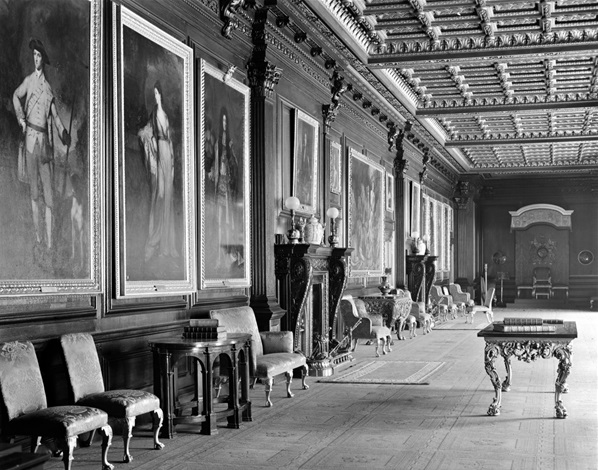The biggest non-royal country house in Scotland was Hamilton Palace. The Hamilton family lived there for many years before making terrible financial and commercial mistakes that resulted in the demolition of the whole building. Many people still believe that the destruction of Hamilton Palace was the worst loss of cultural treasure in Scottish history..
The biggest private residence in Scotland was Hamilton Palace.


Hamilton Palace’s South Front, about June 7, 1919. (Credit for the image goes to Country Life through Wikimedia Commons and Public Domain)
View from the side of the previous Hamilton Palace
The old Hamilton Palace’s South Front and Kitchen or service court, about 7 June 1919.
For over 300 years, the Dukes of Hamilton had their residence at Hamilton Palace in Hamilton, Scotland. The oldest mention of a castle at Hamilton was in a document from 1445. Between 1684 and 1701, the palace underwent a significant enlargement and reconstruction. Alexander, 10th Duke of Hamilton, who owned the palace, brought it to its pinnacle of architectural splendour. At its biggest, it was larger than Buckingham Palace.



The fountain and East front of the previous Hamilton Palace. (Credit for the image goes to Country Life through Wikimedia Commons and Public Domain)
Alexander wanted the palace to be a beautiful setting for his renowned art collection as well as a reflection of his family’s prestige and heritage. Alexander ordered a second palace enlargement between 1822 and 1828, and had the inside decorated with baroque themes and Egyptian-style interior accents to match the splendour of the façade.
The palace’s splendour eventually led to its destruction.


The Hamilton Palace’s Long Gallery, about 7 June 1919. (Credit for the image goes to Country Life through Wikimedia Commons and Public Domain)
The unnecessary architectural alterations made by Alexander accelerated Hamilton Palace’s decline. The Hamilton family incurred significant debt as a result of the building, and the subsidence brought on by the region’s extensive coal mining did nothing to alleviate the problem. The excessive coal mining was steadily eroding the gigantic structure’s structural basis.


The Hamilton Palace’s entrance hall, about 7 June 1919. (Credit for the image goes to Country Life through Wikimedia Commons and Public Domain)
a lobby with high ceilings and checkerboard tile flooring
Hamilton Palace’s Entrance Hall, around June 1919. (Credit for the image goes to Country Life through Wikimedia Commons and Public Domain)
Hamilton Palace was already in serious decay before the start of World War One. The building had been given to the Royal Navy as a hospital during the conflict, but it had since been condemned and was set to be torn down. Hamilton Palace was completely demolished between 1921 and 1926 after all of the Hamiltons’ priceless belongings were auctioned off.


One of the biggest mausoleums in the world, the Hamilton Mausoleum also possesses the longest echo of any structure in all of Europe because to the inside acoustics. (Image Credit: Wikimedia Commons CC BY-SA 2.0; Kevin Rae)
View of the Hamilton Mausoleum from the side
The Hamilton Palace was destroyed in 1921, and all that is left of it is the Hamilton Mausoleum. (Image courtesy of G. Laird through Wikimedia Commons under CC BY-SA 2.0)
Hamilton Mausoleum is all that is left standing



The Hamilton Mausoleum is the only remaining intact part of Hamilton Palace. It was the designated spot where members of the Hamilton family were buried, and it is situated 200 metres from where the main palace building formerly stood. The tomb was built as part of the development under Alexander, starting in 1842 and lasting until 1858.
Family members who passed away before it was finished were buried in a crypt in the palace’s eastern wing, which housed a college church. Alexander believed the family needed a tomb that complemented the design of the massive edifice since the church had grown so run-down. The structure has a huge dome that, with a 15-second echo, holds the world record for the longest echo in a building.
Despite having ordered it, Alexander did not survive to witness the mausoleum’s completion since he passed away in 1852.
6 Impressive Abandoned Military Bases Around the World

There are a lot of military sites all throughout the globe since human warfare has a long history. When the war and the conflicts are over, what happens to them? Many people are only at the mercy of nature. Whether it’s the setting or the architecture, some of these places are very amazing. These are six of the world’s most outstanding former military installations.
Maunsell Forts, United Kingdom
A group of towers known as the Maunsell Forts were constructed in the Mersey and Thames estuaries to aid in the defence of the United Kingdom during the Second World War. They were given the Guy Maunsell moniker in honour of its inventor and were designed to resemble elevated oil platforms. These forts’ construction got under way in 1942. Some of them were run by the Army, while others were by the Navy.


The forts weren’t dismantled until the late 1950s, several years after the conflict was over. Not that they were completely rendered useless, however. Instead, many of them were employed in the notorious Principality of Sealand’s construction as well as by pirate radio stations throughout the 1960s and 1970s. Sadly, in 2007, when a commemoration radio station sought to utilise one of the forts, it was decided that they were dangerous for usage. The still-standing forts are now vacant.
Teufelsberg, Germany
Teufelsberg, which translates to “Devil’s Mountain,” is a fictional mountain. Wehrtechnische Fakultät, a Second World War military college that had not yet been completed, was covered with rubble and debris from West Berlin and was utilised to build it. The US National Security Agency constructed a listening post at the summit rather than letting nature take over.


Teufelberg. (Image credit: Picture Alliance/Getty Images/Monika Skolimowska)
From the time the structure was originally built in October 1963 until the collapse of the Berlin Wall in 1989, it was used as a component of their worldwide intelligence network. The fact that no one knows what the Americans were listening to makes the facility one of its most intriguing features. It’s uncertain if the records containing this information were indeed disclosed in 2020 as planned. Teufelsberg is now gated off, however anybody may still get there for a modest charge.
Wünsdorf, Germany
The military installation at Wünsdorf is intriguing. It is a former Soviet base, however it is located in Germany. It was a military base just outside of Berlin where troops and their families lived after the Second World War while they served away from home. This wasn’t just any base; it was a large complex with a variety of services including stores, schools, and a direct railway to the Soviet Union.


At any one period, 40,000 troops and their relatives resided in Wünsdorf. They continued to function there until the dictatorship was overthrown in September 1994, at which point they were told to return home. The Potsdam Agreement required that numerous bunkers on the property be demolished in order to prevent their use for future military purposes. The region subsequently became abandoned once the German government regained ownership of it.
Alcatraz, United States
Although most people believe Alcatraz was a military facility and not a jail, research has proved that this wasn’t always the case. Due to its prime position for protecting the California coastline, it was first used as a military battery. Fort Alcatraz was built between 1853 and 1859, when 200 troops arrived. The area was more strongly guarded before the commencement of the Civil War, but it ultimately became a jail for privateers and Confederate supporters.


The facility will first become a military jail, then the Alcatraz Federal Penitentiary, it was determined in 1868. Although some people were aware of this past, a group of scholars determined in 2019 that the military infrastructure hadn’t really been destroyed; rather, it had just been covered up. They discovered books, a trench, and other earthworks. Alcatraz is therefore a decommissioned military facility in addition to a closed jail.
Saint-Nazaire, France
Saint-Nazaire, one of France’s main Atlantic harbours, was a crucial area for Germany to seize during the Second World War. To do this, they constructed a U-boat pen to shield their submarines from Allied bombs. The facility was formally inaugurated on June 30, 1941, after construction had started in February of that year. The facility was enormous and included 14 submarine pens, several of which could accommodate two ships.


Along with offices, dorms, kitchens, a hospital, two bakeries, and even a restaurant, it also offered amenities for the U-boat sailors. It was left behind after the conclusion of the war and stood vacant in the French port for many years. It wasn’t until 1994 that the city made the decision to transform it into a viable cultural hub and tourism destination. The old military facility now hosts events including concerts and art exhibits.
Wolf’s Lair, Poland
Specifically during Operation Barbarossa, the Wolf’s Lair, also known as Wolfsschanze, served as the Führer’s main command post on the Eastern Front of the Second World War. Because it was intended to be top-secret, it is situated in Poland’s Masurian woodlands and is only reachable through a tiny train or a private airfield. The Führer spent more time there than anywhere else, hence the place was often utilised.


The website eventually expanded to accommodate this high traffic. It had more than 2,000 employees, three distinct security areas, a minefield, and a neighbouring personal armoured division. In 1944, the Führer was the target of a failed assassination attempt, despite this. The facility was ultimately destroyed at the end of January 1945, leaving behind several partly ruined structures. On January 27 of that year, the Red Army took control of it.
Done 54,000 land mines had been removed by the time the conflict was done. It gradually gained popularity as a tourist destination.